Jamie Perry, painter
Observing people looking at art, a brief stuntman career, and dreaming of a very large donut
Jamie Perry has run from burning buildings, jumped off roofs and mountain ledges, joined in barroom brawls, and driven in car chases. He was not in real trouble, but “enjoyed” a brief stint training to be a motion picture stuntman in Southern California. He ultimately veered on to a less risky career path of artist.
Fortunately, the turn was a smart one that led to a successful and less bruising painting career. Jamie paints moody landscapes, swimming pool divers in midflight, and people viewing art or in the midst of major life transitions.
I came across Jamie’s paintings while visiting the CODA Gallery in Palm Desert, CA. The Palate & Palette team (my husband and I) were touring Palm Springs and Joshua Tree National Park, and wanted to visit the gallery that sold every one of Wendy Chidester’s paintings when she first showed in the gallery. During this visit, Jamie’s paintings caught my attention because they offered a fresh take on midcentury modern fashion and I liked his clever theme of depicting people viewing art.
Jamie grew up in Pomona, CA, trained to be a stuntman, and studied illustration. For a brief time, he worked as a commercial illustrator, but realized that stunt work and commercial art were not the life for him. He transitioned to making fine art and quickly enjoyed success, initially based on the appeal of his landscape paintings.
Do you think there's any parallels with doing stunt work and making art?
Only that both are very risky [career choices]. It's kind of hard to equate the two: lighting yourself on fire and starting a painting.
Were you doing stunts that involved you being on fire?!
Oh, my gosh, yes. We were very safety conscious, not like the guys you see on Instagram diving off roofs onto tables with real bottles on them [I’m clearly not following the right people on Instagram].
My two friends and I had done 70-foot falls, fire stunts, falling downstairs, fights, motorcycle and car stunts—you name it, and we did it.
Why did you stop doing stunt work?
Alan Gibbs—the stuntman who did the iconic scene in Smokey and the Bandit in which the Trans Am jumps over the gorge—befriended me and two friends. Alan did all of Jack Nicholson's stunts and some of Burt Reynolds’ stunts. We became good friends with him and looked to him as a mentor.
He was working with us to get our Screen Actors Guild cards, but unfortunately, he passed away from cancer. Our closest contact and best chance in the business was gone. This was the late 1980s and I was also pursuing an art career, doing illustrations and selling Southwestern paintings at my sister and brother in law’s art gallery in New Mexico. I chose to follow the art route.
What is it like to see paintings that you did in those early days?
Sometimes people will send me some pictures of them, and I see what I could have done better. The paintings were modern and minimal, and had some of my style even back then, but my skills weren't up to par yet.
Your southwestern paintings are probably hanging in somebody's living room and making them really happy.
Yeah, including my mom!
Tell me more about your art path.
I had drawn the comics for the school newspaper in high school, and they were hideous! The perspective, and everything was off. But I guess they got the point across. I wanted to get into advertising and marketing, and eventually realized I was more interested in the art side than the business side, so I took an illustration class from an illustrator, Keith Batcheller, who was an early Disney artist.
From there, I took classes at Cal State Fullerton and ArtCenter in Pasadena, CA: figure drawing, head drawing, marketing your artwork. Then I started working as an illustrator. But after working with some art directors and putting so much time into the work, I realized it wasn't worth it—I was basically getting $5 an hour.
That was almost 30 years ago, and I started out doing landscapes and then I transitioned to figurative pieces around 2009. Now I'm starting to go back to landscapes because I realize that I really love painting them.
Tell me more about your landscapes.
I started doing these very simple, almost Midwestern-looking landscapes that are very flat. I grew up in California surrounded by hills and mountains. When I was younger, my family drove from California to Arkansas to visit my relatives. Driving through Texas, I couldn't believe how flat it was, and every once in a while, I would see a little house, maybe a house and a tree, and nothing near them.
I wanted to make the landscapes minimal and flat, and would paint sunlight coming down on a house with really long, overly dramatic shadows.
Do you remember the first painting you ever sold?
Yes, I sold it to my financial advisor, and she still has it hung in her bedroom. I had done an outdoor show in Lake Tahoe. It was the scariest thing because I hadn't shown my work before.
The other artists were showing paintings in really ornate frames. My landscapes were in simple natural wood floater frames, which at the time, nobody used. I worried that mine didn’t look professional. But within five minutes, I sold the first painting and went on to sell probably 10 out of 14 pieces.
What led to your figurative painting?
At one point, my landscape paintings were in four galleries, and I was doing about six outdoor shows a year. I was putting out pretty close to 200 paintings a year. I started noticing other people painting similar subjects and I realized I should try something different.
At an outdoor show, a man who was a Vietnam vet in a wheelchair began looking at my paintings and stared at one for a solid 10 minutes, looking at it closely. I thought he was an artist looking at my technique, but then he said the painting reminded him of a house he grew up in. I loved the way he interacted with the painting. It gave me the idea to start painting people looking at my paintings.
At the time, my [now] late brother-in-law was really into Jackson Pollock, so I created a couple with him looking at a Pollock-esque painting. Those really took off. From there, I started putting figures in different settings, and painted people jumping into swimming pools.
Sometimes you use models.
I will almost always use a model for paintings involving the human figure, because I'm not that great at making up the shadows. Also, I can be more exact, especially when the models are wearing vintage fashions. My buddy’s daughter is in 90% of the figurative pieces with women. [Jamie takes photos of the models, citing Norman Rockwell as an influence in that regard.]
Tell me about your recurring character, the man in the hat with the suit jacket.
Oh, that guy. I love vintage fashion. I don't dress it, but I have boxes and boxes of photographs of my mother's parents and relatives in the '40s and early '50s.
The men are always wearing suits and hats. Even at baseball games, they've all got a fedora on. I love that look and am drawn to that era. Most of the women I paint are also wearing vintage fashion.
How are you choosing the art that your subjects are viewing in your paintings?
A lot of them are abstracts that I'll make up. I've always, ever since my illustration days, drawn and painted everything tightly rendered. It's nice to steer away from the details and just let loose with palette knives, which I hardly ever use, and splatter paint and come up with my own little abstract. I'll mask the person off before I do that part.
How do you start a painting?
I'll start with an idea and usually I have a vision in my head of exactly what I want to paint and what colors I want to use. If I need subjects, I'll photograph them. Then I'll start with sketches. I usually work in square. But if it needs different dimensions, I'll photograph it and put it on my computer and then edit it to get the composition I want. From there, I will do a grid.
I always paint on black gesso and draw in white chalk. I started that when I was painting landscapes because they were kind of ethereal and dark, and I hardly ever work on a white canvas. After I do the grid, if there's sky in the painting, I start with the sky to set a mood for the rest of the painting. Then I'll do a little underpainting.
How do you approach underpainting?
If I'm working in a cool color, I will underpaint in warm, almost always, so the underpainting is usually opposite of what I paint over it. Sometimes you can see the warmth come through in some of the cool colors that are laid out on top.
Have you done a painting that you considered an artistic breakthrough?
The girl with the suitcase, which was one of my first paintings that didn't involve somebody viewing art.
It’s called Moving On. A friend of mine was leaving her husband, and it was a fresh break for her. I added the vintage spin on it and put my little French bulldog in there looking at her.
Tell me more about your French bulldog.
I love that little guy, Ace. He's my muse, definitely. Sometimes I change the color of his spots so that a viewer doesn’t always see the same dog every time.
Does Ace hang out with you in the studio?
He does. I call him my shadow because he follows me everywhere.
You have a painting called Artist’s Block, and it shows paint splattered shoes in front of a blank canvas. Have you had artist’s block?
That's how that painting came about. I was sitting with my feet up on the easel staring at a blank canvas. I was getting ready for a show in Palm Desert.
I realized it was such a great composition with my feet in front of the blank canvas and my paint-splattered jeans and tennis shoes. That's exactly how my shoes looked. I ended up painting it and it was one of the first pieces that sold in the show.
What do you do when you have artist block besides paint your splattered shoes?
I’ll go through the thousands of photographs of people and landscapes that I started collecting 18 or 20 years ago, and I'll use one as a starting point.
Did your painting I Dreamt of a Giant Donut come from a dream?
It did! I had a dream that I baked a giant donut, and I took it to a bake sale.
We almost never see your subject's faces straight-on. I'm pretty sure, given your illustrative talent, that you know how to draw people's faces.
I've drawn people's faces, and viewers get fixated: Who is that? Do I know them? I want to keep things mysterious by not showing who that person is. I don't need to show the face for viewers to get the meaning of the painting.
Have you ever done a self-portrait?
Yes, it’s a view from behind me. I’m sitting at an easel painting an oncoming tornado. I don't know the psychological meaning of that. It was probably three years into painting that I painted that. Unfortunately, I didn’t take a picture of it to share.
If a painting of yours could be on any book cover, what book would want it to be?
On the Road by Jack Kerouac. I've got a couple of pieces that would probably work well for that book.
Your paintings tend to be large. Is it because you like the results that you get at that scale or because the market wants large paintings?
About eight out of 10 pieces that sell will be 36” x 36”. I think they work in a lot of people's houses. I would love to paint larger pieces, but not everybody has the budget for that. I think about people who are just starting their art collecting and want something a little bit more affordable, so I also sell 24” x 24” pieces and panoramic pieces that are 20” x 55” to 20” x 60.” [Like a majority of working artists, there seems to be a devotion to pricing based on a canvas’ square inches total, perhaps to keep things simple and fair to all buyers.]
What’s the largest painting you’ve done?
It was 60” x 112”. I love working large-scale. A collector had a dream of a couple walking on the beach with a storm coming in. The wind blew a bright red umbrella out of the woman’s hand and she is reaching up to grab it.
Who are some of the painters and creative people you admire?
Edward Hopper, Andrew Wyeth, and a painter out of California, John Register. Early on I was inspired by Edward Hopper but then I saw a retrospective of John Register at Pepperdine University around 2000, and that changed the way I painted. I began using a more vibrant palette, as he did.
I had only seen his paintings in books before, and seeing the large scale of some of his paintings just blew me away.
Do you have a dream painting that you want to do?
A huge landscape. In the early days, I was painting a lot of thunderstorms. I live around 30 miles from Denver. If I go another 10 miles east, the landscape starts getting really flat with low rolling hills. I want to paint a scene that’s dark and stormy with little spots of light coming down on the plain. I like seeing thunderstorms in flat landscapes and find it awe-inspiring.
Speaking of thunderstorms…I have some lightning round questions.
What’s the most memorable meal you've ever had?
My wife and I went to a Christmas dinner party and we knew 40 to 50 people were invited. We got there a little early and waited in the car because we didn’t want to be the first people there. After waiting awhile, we checked and realized the dinner was the following weekend! So, we went to a little Italian restaurant in Corona, CA, that we always wanted to try. We had great wine, and a great meal, and my wife and I always talk about it because we had the greatest time.
Do you have a painting of yours that you won't sell?
Yes. It's called Family of Four. I come from a family of four: my mom, my dad, my sister, and me. And my family is my wife and me and my two stepchildren. We had moved into a new house in Riverside—up in the hills. I photographed four eucalyptus trees with these golden hills in the background, which was nearby, and painted the scene. A day or two later, the trees had completely burnt down in a fire. I will not let that painting go.
What's your favorite piece of art that you own?
That one and a painting by Brian Blackham of Utah. It’s a loose piece with a can and a pear.
What's your favorite dessert?
German chocolate cake. My mom would always make it for me on my birthday.
Most captivating art viewing experience.
Seeing the John Register retrospective.
Palate & Palette menu
I’m going full 1980s Silver Palate Cookbook with this menu, because Jamie and I grew up around that time in Southern California (don’t ever call it Cali if you want to sound like a local) and listened to a lot of the same punk music of the time. Here’s what I would serve if Jamie and his wife came for dinner, which they are invited to do:
Flatbread with goat cheese and sun-dried tomatoes
Caesar salad
Chicken Marbella
German chocolate cake
Where to find Jamie Perry
CODA Gallery, 73400 El Paseo #B1, Palm Desert, CA
CK Contemporary, 246 Powell St, San Francisco





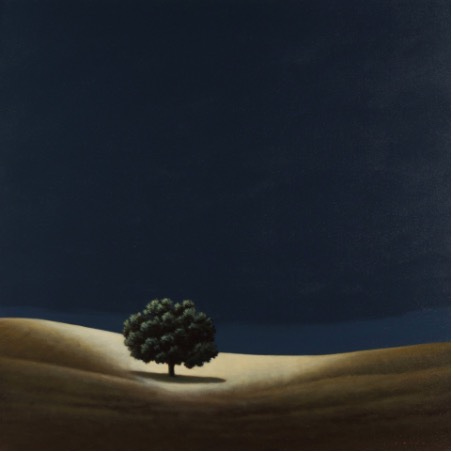
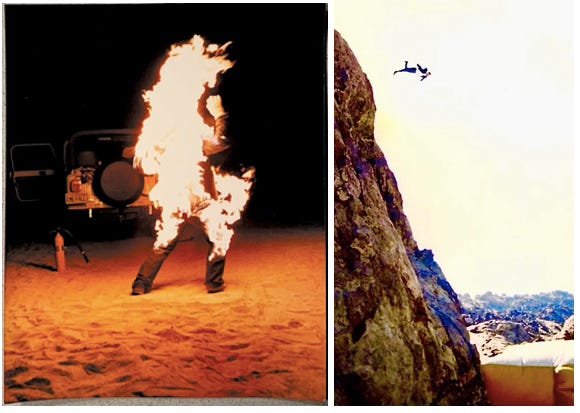
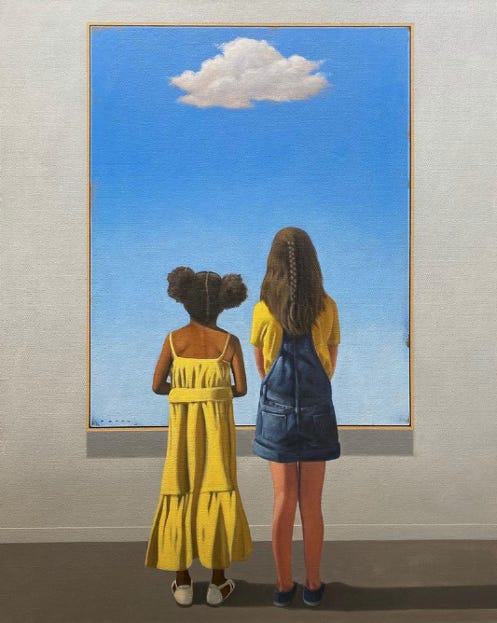
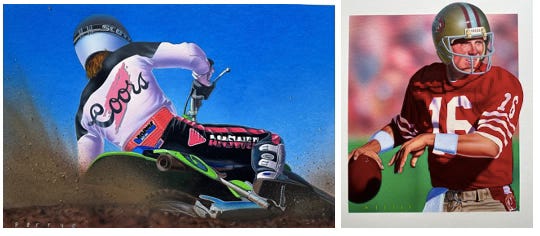
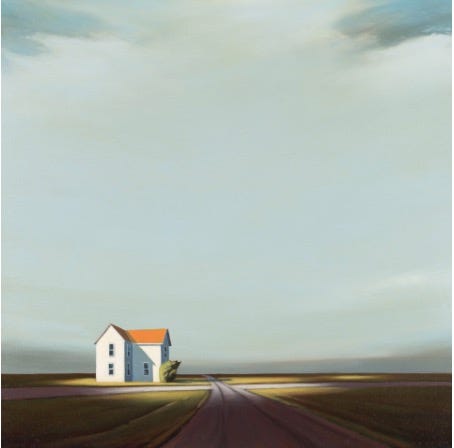


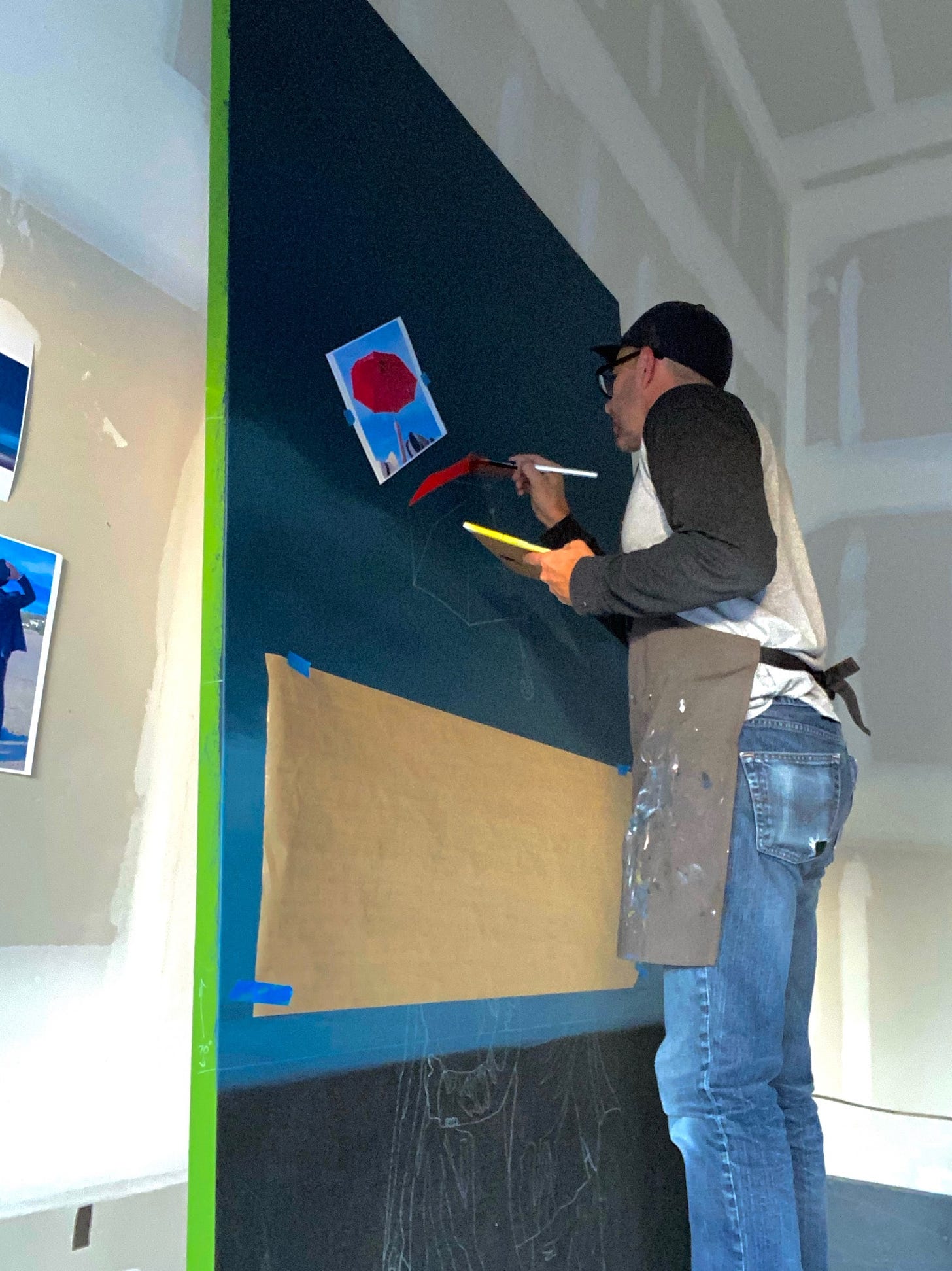
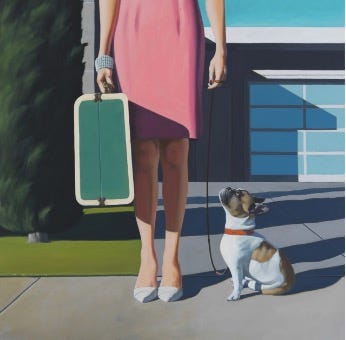
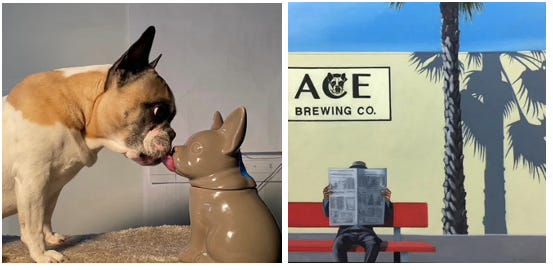
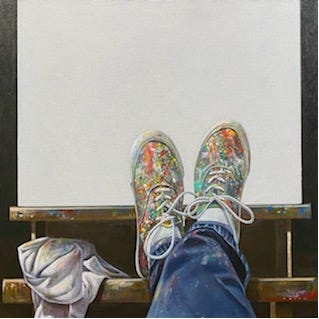
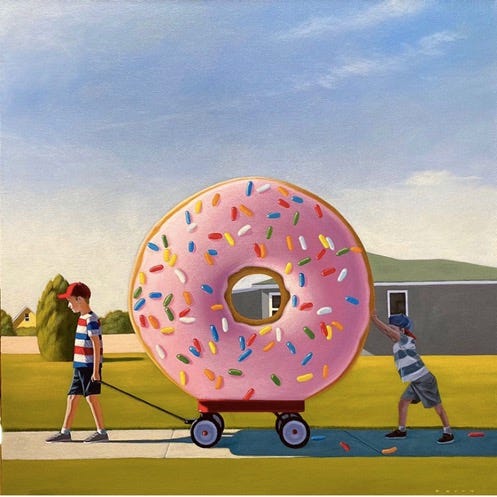
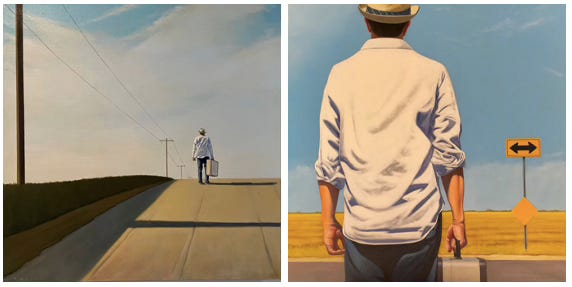

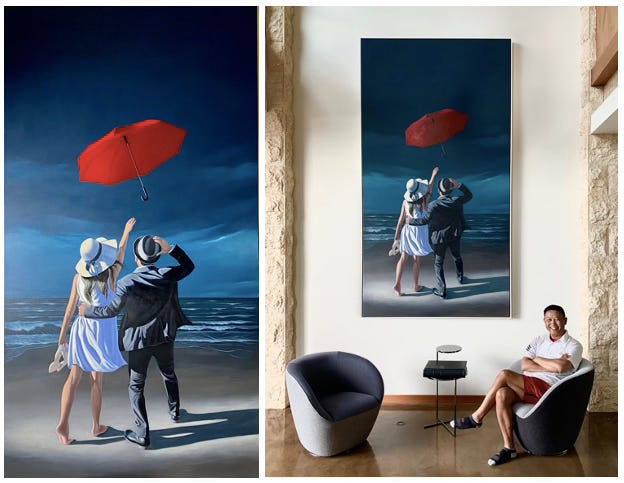
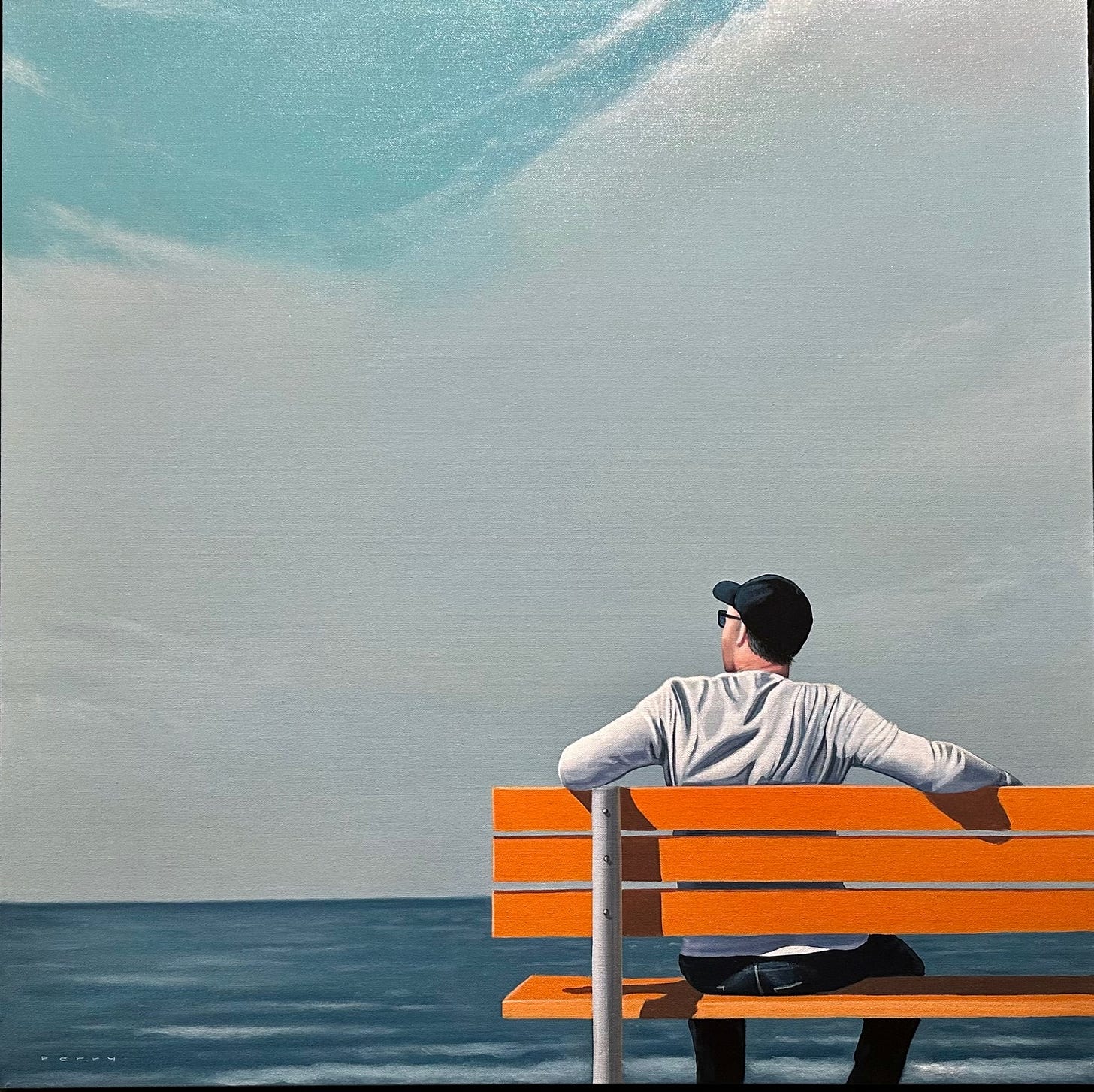


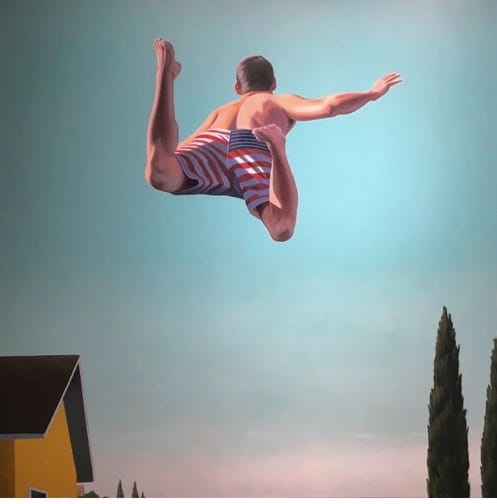
I really enjoyed this interview and Jamie's paintings! I'm crazy for "I Dreamt of a Giant Donut." And now I know about John Register, whom I hadn't encountered before. Thank you!
What an interesting career transition. I love "Crossways". It has a beautiful, haunting quality. So much technical skill. Thank you for sharing!